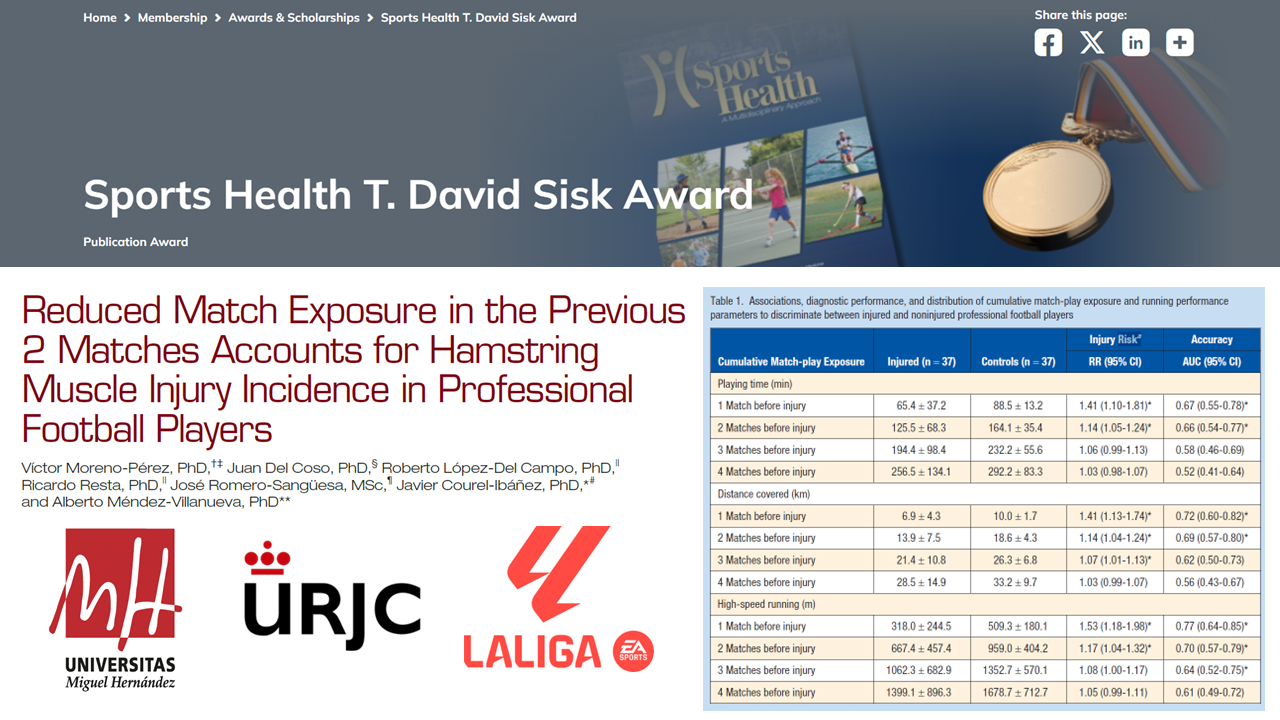
20 May “Sometimes, the greatest risk isn’t playing too much… but not playing enough”
What sports science just revealed about muscle injuries in professional football (and why it should change how coaches manage rotation and training loads)
For years, it’s been assumed that the main trigger for muscle injuries in professional football was overload: too many matches, not enough rest, excessive sprinting. But a new study, recently awarded as the Best Original Research Article of 2024 by the prestigious Sports Health journal, challenges that narrative. Based on official data from LALIGA, the research shows that not playing enough can also increase the risk of muscle injury, particularly in the hamstrings.
And that changes everything.
This rigorously conducted and internationally awarded study goes beyond intuition. It relies on objective data collected over three full seasons from two top-tier Spanish teams. The core insight? A lack of competitive exposure in the previous matches significantly increases the likelihood of sustaining a muscle injury. (https://doi.org/10.1177/19417381231158117)
The study: a new lens on injury risk
Using Mediacoach tracking technology, researchers logged match data, minutes played, total distance, and high-speed running efforts. They compared players who sustained a hamstring injury with teammates of the same position who remained injury-free.
The findings were clear and statistically robust:
- Players who had played fewer than 64 minutes in their last match were at much higher risk.
- Those with less than 95 minutes accumulated over the last two matches were also significantly more likely to get injured.
- This increased risk wasn’t linked to training load, but to a lack of recent match exposure.
- Additional thresholds: less than 5.8 km or 328 m at high-speed in the last match, and less than 12 km or 901 m at high-speed over the previous two.
The study also found that workload three or four matches prior had no significant relationship with injury, confirming the risk is short-term and immediate.
Why this matters for professional coaching and performance staff
Every team has players who fit this risk profile: bench players, rotational squad members, recovering athletes, or youth players just entering the first-team dynamic.
This research allows you to:
- Identify players at elevated injury risk due to low match exposure.
- Design tailored high-intensity compensatory sessions to replicate competitive demands.
- Plan reintegration more carefully, especially when reintroducing players with limited recent minutes.
- Include exposure history in rotation decisions, ensuring not just who plays, but who hasn’t played, is factored in.
In short, underexposure is now a new injury risk marker you can track and manage.
A research line with real impact on professional football
This awarded paper is part of a broader scientific collaboration between LALIGA’s Football Intelligence & Performance department, Universidad Miguel Hernández (UMH), and Universidad Rey Juan Carlos (URJC).
In 2022, the same group won Spain’s National Award for Sports Medicine Research for a groundbreaking study on genetics and injury risk. It showed that players with the ACTN3 XX genotype, who lack a key protein for fast-twitch fibers, had:
- Lower high-speed performance
- Higher rates of muscle injury
This research opened the door to personalized prevention based on genetic profiling—without being used for selection purposes. (https://doi.org/10.3390/genes15030386)
Other key studies already applied by professional clubs
This line of research has produced several peer-reviewed studies, all based on real competition data, with direct impact on injury prevention strategies:
- Weekly and in-game workload: Muscle injuries were more likely after high-intensity load accumulation during the week and a short spike in the five minutes before the injury.
(https://doi.org/10.1055/a-1533-2110) - Short-term effort before injury: In 88% of hamstring injuries, players had performed an unusually high running load in the five minutes prior, compared to their typical match profile.
(https://doi.org/10.5114/biolsport.2024.127387) - Post-injury performance deficits: Players with moderate to severe muscle injuries take several matches to regain pre-injury sprint and metabolic output levels.
(https://doi.org/10.26582/k.55.2.18) - COVID-19 return-to-play strategy: After the lockdown, teams that followed a structured reconditioning protocol avoided the expected injury spike, despite a highly compressed schedule.
(https://doi.org/10.3390/ijerph19052920)
Key takeaway: monitor your least-exposed players
The key shift is this: we must stop focusing only on those playing the most. This study shows that players who play the least may actually face the highest risk—if they’re not properly prepared.
From weekly planning to matchday rotations, integrating underexposure into your injury risk model can help you:
- Avoid preventable muscle injuries
- Use your full squad with confidence
- Keep key players available and competitive longer
Because protecting your players also means understanding who’s not yet at risk… but soon could be.


